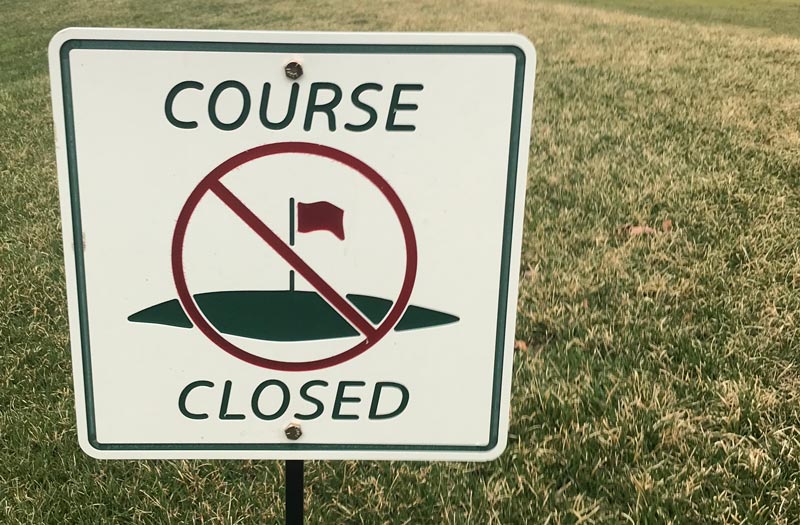
Sign of the times: Petrifying Springs Golf Course in Kenosha, Wis., has been closed since March 24 following Gov. Tony Evers’ “safer at home” order in response to the coronavirus outbreak. Photo by Ryan Retherford
Ryan Retherford had a difficult enough time keeping track of the on-again, off-again status of golf in the wake of the coronavirus pandemic. Now, with his course officially shuttered, the superintendent has another — largely unanticipated — concern: poachers.
Retherford, who oversees Petrifying Springs Golf Course in Kenosha, Wis., has been dismayed to see folks walking onto the course and playing golf despite the fact that the property has been closed to the public since early last week.
“As a whole, I’ve talked to plenty of superintendents,” says Retherford, a 12-year GCSAA member. “They’ve had the same issue when they’re closed. You know, if it’s a private course lined with houses, if you live on the golf course, you see people sneaking out and punching irons around, putting around. So I don’t think that’s anything new. But the fact people have been held inside — it entices them to get outside a little more.”
Petrifying Springs GC had been open for a little over a week, Retherford says, when Wisconsin Gov. Tony Evers issued the “safer at home” order on March 24. There was some uncertainty at first as to whether that order included golf courses. The government later clarified that all golf courses in the state indeed had to close, but said that essential maintenance can continue for the time being. The order runs through April 24.
At county-owned Petrifying Springs, that means Retherford — who has been at the facility almost exactly one year — is carefully juggling his four-man staff.
“We’re sticking to a strict protocol,” he says. “Six feet apart. No vehicles together. No congregating in the break room. The list goes on. We take pride in how strict we’re following the protocol. We want to continue to work. We want to comply.”
And that’s part of what troubles him about the folks helping themselves to free golf.
“Wednesday was absolutely gorgeous,” Retherford says of the previous week. “I’d never seen so many people at the county park that’s next to us. That’s when I realized it might be a problem. It’s a sensitive issue, because some of those guys are season-pass holders, and you want to honor that fact. And I can’t blame people for wanting to get out and enjoy the day, and you want to let people come out and enjoy the course, but only if they respect proper etiquette.
“The last couple of days, people have been trying to sneak on and play. It doesn’t affect me personally, but it’s one of those unforeseen things, and I’m not sure if other superintendents are dealing with it or thinking about it. Will it get your course in trouble? What’s going to happen? It’s really unclear.”
Referencing the course’s practice facility, Retherford says, “People want to play on that. But I wonder where the line is drawn. You don’t want to put other people at risk. They’re trying to get away with free golf, and in some way, I can’t blame ’em. People want to get outside and play golf. But we’re sticking to a strict protocol with our maintenance crew, and I don’t want people putting our crew at risk.”

Petrifying Springs Golf Course is an 18-hole, county-operated facility set in the heart of the 350-acre Petrifying Springs Park in Kenosha, Wis. Photo courtesy of Petrifying Springs Golf Course
The golf course is essentially bare — Retherford and his crew have stripped it. There are no coolers or rakes or flagsticks, and cups have been installed upside down. Carts are locked up.
“If they’re out there, they’re out there with their own push carts and their own clubs,” Retherford says of any trespassers. “We’ve taken all the proper precautions. But I’m concerned about repercussions for the golf course. We’re not coming in on weekends. We have proper signage up, saying the golf course is closed, but over the weekend, we can’t stop anyone from coming out there.”
Retherford deals with the interlopers when he can.
“I tell my guys not to approach the guests,” he says. “That’s my job, or the pro shop’s job. Fortunately, I haven’t seen any vandalism yet. Our concern is if there’s a huge flush of people. Typically, we don’t see families walking on the course with their dogs running wild like we are now. But they’re overflowing onto the course. The other day, it was like a public park.
Everybody was walking across every surface. I didn’t see anybody do anything harmful. We confronted the majority of them, but it’s one of those things. I think it will continue.”
As long as the golf course maintenance team can continue to work — Retherford says staff members have to wear their county ID badges at all times in case they get “pulled over” — it will.
“We came out of winter great,” Retherford says. “We were excited to open, and everyone else was too. One positive is that we can concentrate on aerating the greens without being disrupted. This place is going to be as pristine as we can make it.”
That’s the best case. Worst case? Retherford and his team are told to stay home.
“I think that would be our worst nightmare,” he says. “It sounds insensitive to say, but you have to maintain it. If we’re shut down longer than two weeks ... I don’t know. We’re hoping that doesn’t happen, but I honestly don’t know. The good part is, we’re not growing out of control yet. But temps are creeping up, and we’re starting to green up. Two weeks from now, we might start getting behind on mowing. But my biggest fear is applications. Applications now are pretty important for the rest of the season.
“We’ll get as many applications down now as we can and hope these guys can keep working. We’re lucky we get to work outside. People who are quarantined, people who work in offices all day ... they’ve got to be miserable.”
Andrew Hartsock is GCM’s managing editor.